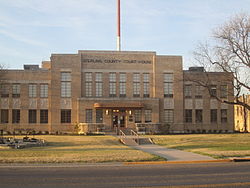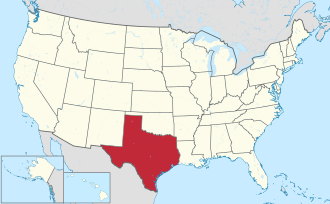Ranching
In the 1870s, the area was dominated by large land and cattle outfits such as the Half Circle S, established by the Peacock brothers; the MS, set up by Schuster, Henry, and Company; and the "U" Ranch, established by J.D. Earnest and W.J. Holland.
In 1879, Colonel William Randolph McEntire purchased the 80,000-acre (325-km2) "U" Ranch from M.B. Stephenson. Established in 1876 by J.D. Earnest and W.J. Holland, and later sold to M.B. Stephenson in 1879, the "U" Ranch was the first ranch established west of San Angelo in Tom Green County, Texas. The ranch was located about six miles northwest of Sterling City on the North Concho River extending northwestward through Glasscock County to the headwaters of the river in Howard County, the Sterling Creek (headwaters to the mouth of the river) in the east/southeast, the Renderbrook Spade Ranch in Mitchell County in the northeast and J.B. Slaughter's ranch in the northwest. [11] [12] The ranch itself consisted of three headquarters - one on the Concho, one at the mouth of Sterling Creek and one at the headwaters of Sterling Creek - and were twelve to twenty-five miles apart.
After subsequent land acquisitions, the "U" Ranch was enlarged to include over 250,000 acres (1,000 km2) and eventually bordered the Seven-D Ranch in Pecos County in the south/southwest. During the era of the open range, the alternating "odd-numbered" sections of land retained by the State of Texas were freely accessible to the large cattle outfits that owned the "even-numbered" sections of land; therefore, the "U" Ranch controlled an additional 250,000 acres (1,000 km2) of rangeland, bringing the total amount of land owned or controlled by W.R. McEntire's "U" Ranch to roughly 500,000 acres (2,000 km2). During this time, the "U" Ranch grazed upwards of 50,000 head of cattle across five counties, with the cattle being driven to pasturage outside of Texas or to cattle feedlots to increase the animals' weight prior to the final drive to cattle markets in Fort Worth, Kansas City, Chicago, and St. Louis.
Large cattle drives to Colorado City and Fort Worth routinely occurred between 1875 and the mid-1880s, at a time the region was still open rangeland. The "U" Ranch drove the cattle northward to Colorado City, the nearest railroad, and shipped the cattle to Arkansas, Kansas, Nebraska, Wyoming, and Marlow Indian Territory. In 1882, W.R. McEntire, J.B. Wilson, and C.C. Slaughter drove 89 carloads of cattle, mostly overland, to rangeland in Orin Junction, Wyoming that was controlled by the Driskill brothers, who also owned a hotel in Austin, Texas. The cattle weighed 600 to 800 pounds upon arrival and within two years, they weighed almost 1,400 pounds each. By 1888, W.R. McEntire's eldest son, R. Billie McEntire, and his crew were responsible for driving the "U" Ranch cattle to new pasturage outside the state, or often experimenting with various feed types at the feedlots, and subsequently bringing those cattle to the markets as soon as certain market prices were attained. During his last cattle drive in 1893, they began experiencing inclement weather as soon as they left the "U" Ranch towards Colorado City and as they neared the Renderbrook Spade Ranch, a snowy blizzard moved in from the north. R. Billie, knowing the owners, the Snyder brothers, cut the perimeter fence and drove over 1,000 head of cattle southward into the main horse pasture of the Renderbrook Spade Ranch while the McEntire crew weathered the storm at ranch headquarters over several days. With minimal losses after the blizzard, the McEntire crew continued the drive towards Colorado City and the feedlots in Pine Bluff, Arkansas. R. Billie kept the cattle at the feedlots for 10 months waiting for ideal market conditions in Fort Worth. In Arkansas, he married Eudora Fowler and subsequently moved to Dallas to work at American National Bank, which his father, W.R. McEntire, founded and controlled with C.C. Slaughter, the owner of the Lazy S Ranch. R.B. McEntire's younger brother, George, also followed the same path, learning finance at American National Bank in Dallas prior to returning to Sterling County and subsequently either assuming ownership or control of the ranch.
Between 1880 and 1900, W.R. McEntire acquired additional rangeland throughout Glasscock, Howard, Mitchell, Nolan, Sterling, Tom Green, and Reagan Counties, enlarging the "U" Ranch operations to include over 250,000 acres (1,000 km2) with approximately 105,000 acres (420 km2) located in Glasscock and Reagan Counties. The "U" Ranch now extended from 12 miles west of Garden City to Grierson's Spring in Reagan County, included the section of the Goodnight-Loving Trail between the Concho and Pecos Rivers and bordered the Seven-D Ranch in the southwest. Grierson's Spring is located between the head of the Concho River and the Pecos River, about 15 miles southwest of Big Lake in Reagan County and 30 miles east of the Pecos River, while the Seven-D Ranch headquarters was located on Comanche Creek four miles east of Fort Stockton in central Pecos County.
Under the new Homestead Law, settlers began purchasing the “even-numbered” sections from the state for the benefit of the Common School Fund in 1883. In conjunction with the introduction of the fence, these settlers began owning land that was previously controlled by the large cattle outfits, and this eventually led to the Fence Cutting Wars. This acreage was sold by the state on a first-come, first-served basis with the county advertising the availability of land, which resulted in extremely long lines at the county clerks' offices and increased the likelihood that the desired acreage would not be available. As a result of the Common School Fund process, W.R. McEntire, while in Dallas, sent representatives from Tom Green County to acquire as much land as possible and to keep others out of the line until the desired acreage was obtained. North Carolinian James Jefferson Lafayott Glass came to the county in 1883 and signed on with the Sterling Brothers’ Half Circle S outfit. He later homesteaded acreage along the Lacy Creek. [13] [14] [15]
As the era of the open range began to conclude, W.R. McEntire realized that contiguous acreage would be increasingly important to the success of any cattle outfit, and he began quickly purchasing any available acreage with the prospect of establishing a buffer around the "U" Ranch, or selling or bartering that acquisition for adjoining acreage to his primary operation, either under a single operation and single fence line, or perhaps having access to large, disparate ranches that could provide the ability to easily move livestock between operations. As a reaction to the continued encroachment of squatters and homesteaders from the growing settlement of Sterling City, W.R. McEntire purchased 10,000 acres west of Sterling City in 1884, near the intersection of the Lacy Creek and Concho River.
In 1890, W.R. McEntire sold the 105,000 acres (420 km2) in Glasscock and Reagan Counties, including 3,000 head of cattle and 100 horses, to J.B. Slaughter, which subsequently became the first U Lazy S Ranch. [16] [17] In 1898, J.B. Slaughter sold the acreage and moved his cattle and operations to his new U Lazy S Ranch in Borden and Garza Counties.
In 1896, R. Billie McEntire returned to Sterling County and purchased about 10,000 acres which adjoined the "U" Ranch headquarters and included portions of the Kennedy Ranch, Half Circle S Ranch, and the Peacock-Kellogg Horse Ranch.
The era of the large open-range cattle kings had come to a close by 1890, with the MS Ranch and Half Circle S Ranch being bankrupted, and the "U" Ranch in the process of being consolidated into contiguous acreage.
U Ranch Legacy
The derivatives of W.R. McEntire's initial "U" Ranch are currently owned and operated as distinct ranches by his descendants. These ranches are the only remaining segments still in existence of the first large cattle outfit in the region. In 1906, W.R. McEntire divided his ranching estate between his two sons, R. Billie McEntire and George H. McEntire. while his daughter, Lula Elizabeth McEntire, received non-agricultural property.
R. Billie McEntire’s Operations
R. Billie McEntire received the Harrison Ranch in Dallas, the N+ Ranch in Sterling County, and cash from the dissolution of McEntire & Co. and investments in the American National Bank in Dallas. That same year, he purchased 10,000 acres in Nolan and Mitchell counties and moved his family to Colorado City, Texas. Around 1915, his four sons—Fowler, James H., W.R. Jr., and R.B. Jr.—formed the McEntire Brothers partnership to manage the family’s ranching operations, which totaled about 20,000 acres split between Sterling County and Nolan/Mitchell counties. The partnership dissolved in 1928 as the brothers took over individual operations. In 1927, R. Billie sold his Sterling County acreage to his sons, with Fowler and James H. later consolidating full ownership.
James H. McEntire established the Campstool Ranch in its current form by 1925, on land originally acquired by his grandfather in 1884. Following James’s death in 1937, his wife, Sudie Rawls McEntire, managed the ranch until 1955, when their daughter, Jamie Sue McEntire Cole, and her husband, Bill James Cole, assumed operations, becoming full owners in 1981. Under Bill Cole’s leadership, the ranch expanded to about 35,000 acres across Crockett, Glasscock, Sterling, and Val Verde counties. In 1963, a sheep feedlot with a 32,000-head capacity was constructed on the ranch, later used primarily for their own livestock. In 1969, the Coles founded Custom Skins, Inc., a San Angelo-based sheepskin tanning company that became a leading domestic and international supplier. By the 1980s, operations expanded into Colorado and California, making the family one of the largest individual producers of sheep and wool in the United States. To support this growth, Cole Trucking was established, operating a dedicated fleet between Texas and California. After selling all livestock in 1989 in anticipation of a market peak, the Coles refocused on Texas, acquiring an additional 40,000 acres between 1989 and 1992. In 2008, they sold a 9,000-acre Sutton County / Schleicher County ranch. Bill Cole was recognized by the Crockett County Soil and Water Conservation District for over 50 years of conservation practices, including brush and wildlife management and erosion control.
George H. McEntire’s Operations
George H. McEntire inherited 23,000 acres and operated the U Ranch in partnership with his father under the name McEntire & Son. In 1962, he transferred 16,233 acres each to his two children, George H. McEntire Jr. and Virginia McEntire. George Jr. continued to operate under the U Ranch name, while Virginia established the VJ Ranch.



